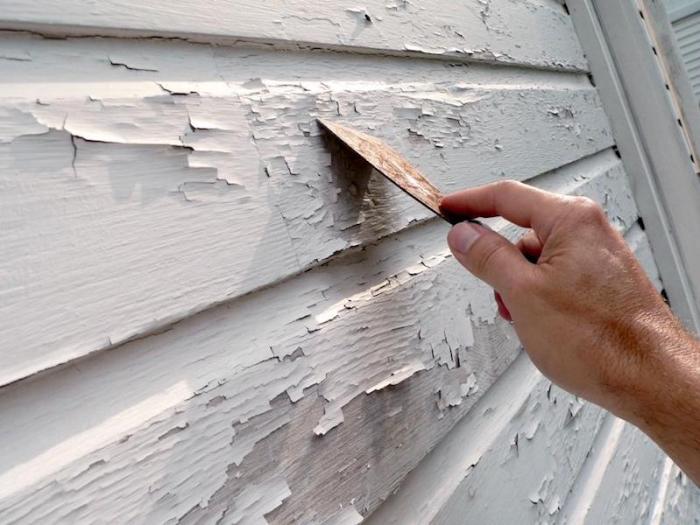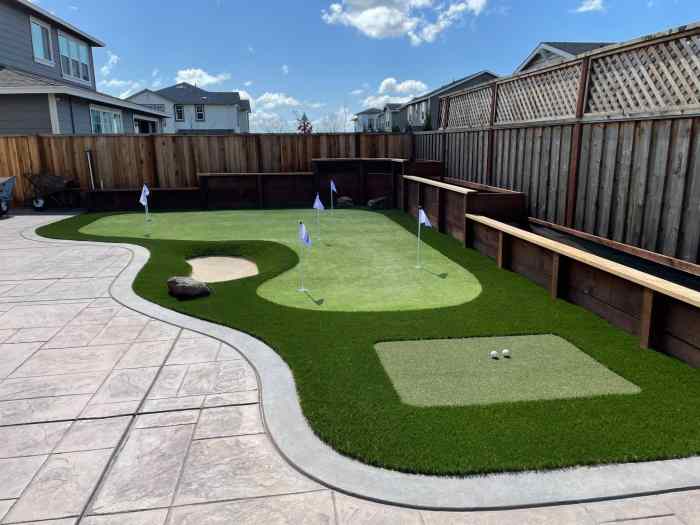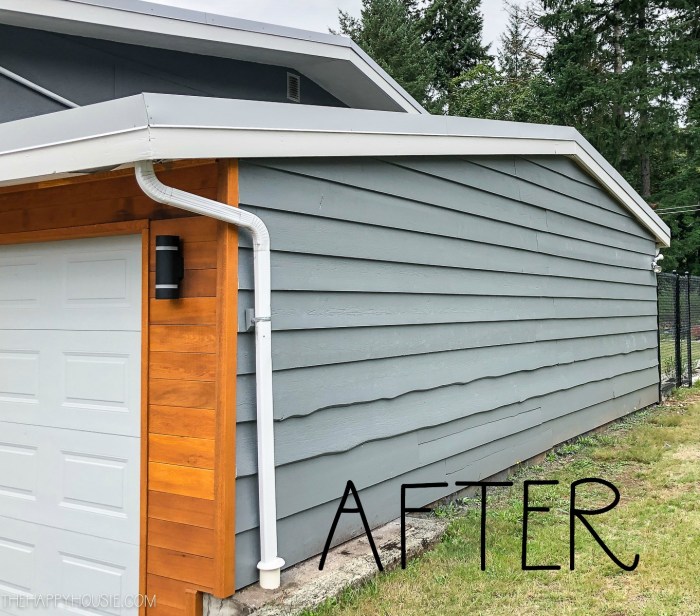Remove Green From Siding A Cleaning Guide

Remove green from siding? It’s a common homeowner problem, but don’t worry, it’s totally solvable! This guide tackles everything from identifying the source of that unsightly green growth (is it algae, mildew, or something else?) to the best ways to clean it off, whether you’re tackling it yourself or calling in the pros. We’ll cover safe cleaning methods, preventative measures, and even show you some amazing before-and-after transformations.
We’ll walk you through different cleaning solutions, from simple bleach mixtures to powerful pressure washers, explaining the pros and cons of each. Learn how to safely use a pressure washer without damaging your siding, and discover the best preventative strategies to keep your siding looking its best for years to come. We’ll also explore the costs involved in DIY versus professional cleaning, helping you make the best decision for your home and budget.
Identifying Green Siding Issues
That unsightly green growth on your siding isn’t just an aesthetic problem; it can signal underlying issues and lead to significant damage if left unchecked. Understanding the different types of growth and their causes is the first step to effective removal and prevention.
Understanding the different types of green growth affecting your siding is crucial for choosing the right cleaning method. Algae, mildew, and other organisms thrive in different conditions and require different treatments. Ignoring the problem can lead to long-term damage and costly repairs.
Causes of Green Discoloration
Several factors contribute to the growth of green discoloration on siding. Moisture is a key element; areas with poor drainage, excessive shade, or infrequent sunlight create ideal breeding grounds for algae and mildew. Furthermore, the presence of organic matter, such as leaves or decaying plant material near the siding, provides nutrients that fuel growth. Finally, the siding material itself plays a role; some materials are more susceptible to discoloration than others.
Differentiating Algae, Mildew, and Other Green Growths
Algae typically appears as a slimy, dark green film, often found in damp, shady areas. Mildew, on the other hand, presents as a powdery, fuzzy growth, usually lighter green or grayish-green in color. While both are common, other organisms like moss can also contribute to green discoloration. Moss is generally more textured and grows in patches, unlike the more uniform spread of algae or mildew. Proper identification is crucial for effective treatment; a simple visual inspection often suffices for distinguishing these growths.
Long-Term Effects of Untreated Green Discoloration
Leaving green growth untreated can have several detrimental effects. The organisms can gradually penetrate the siding material, causing staining, discoloration, and even structural damage. Algae and mildew can weaken the siding’s integrity, making it more vulnerable to weathering and other forms of damage. Moreover, persistent growth can diminish the curb appeal of your home, affecting its overall value. In severe cases, extensive damage may require costly repairs or even siding replacement.
Siding Materials Susceptible to Green Growth
Various siding materials exhibit varying degrees of susceptibility to green growth. Wood siding, due to its porous nature, is particularly prone to algae and mildew growth. Vinyl siding, while generally more resistant, can still be affected, especially in consistently damp environments. Fiber cement siding, though durable, can also experience discoloration if not properly maintained. The level of susceptibility also depends on factors like the siding’s age, condition, and the climate of the area. Regular cleaning and preventative measures are recommended for all types of siding to minimize the risk of green growth.
Cleaning Methods for Green Siding: Remove Green From Siding

Source: com.au
Cleaning green siding effectively requires choosing the right method and solution. The type of siding, the severity of the algae or mold growth, and environmental concerns all play a role in determining the best approach. Improper cleaning can damage your siding, so careful consideration is key.
Cleaning Solutions Comparison
Several solutions can effectively remove green growth from siding, each with its pros and cons. Bleach solutions are inexpensive and readily available, but can be harsh on certain siding materials and the environment. Commercial cleaners, while more expensive, are often formulated to be gentler and more effective on specific types of siding and stains. Pressure washing provides mechanical force to remove the growth but can damage siding if used incorrectly.
Pressure Washing Siding: A Step-by-Step Guide
Pressure washing can be effective, but improper use can damage your siding. Always start by testing a small, inconspicuous area first to check for any adverse reactions.
- Prepare the area: Clear the area around the siding of any obstacles, such as plants or furniture. Protect landscaping with tarps or plastic sheeting.
- Choose the right nozzle: Use a wide-angle nozzle to prevent damage to the siding. A 25-40 degree nozzle is generally recommended.
- Mix your cleaning solution: If using a cleaning solution, follow the manufacturer’s instructions for dilution ratios. For a bleach solution, a common ratio is 1 part bleach to 3 parts water, but always test in an inconspicuous area first.
- Apply the solution: Apply the cleaning solution to the siding using a garden sprayer or low-pressure nozzle. Allow the solution to dwell for the recommended time, usually 10-15 minutes.
- Pressure wash: Begin pressure washing from the bottom and work your way up. Maintain a consistent distance of 12-18 inches from the siding. Overlap your passes to ensure complete coverage.
- Rinse thoroughly: Rinse the siding thoroughly with clean water to remove all traces of the cleaning solution.
- Allow to dry: Allow the siding to air dry completely before assessing the results.
Safety Precautions for Pressure Washing
Always wear appropriate safety gear, including safety glasses, gloves, and closed-toe shoes. Protect your skin and eyes from the cleaning solution and water spray. Never point the pressure washer at yourself or others. Be mindful of electrical outlets and other sensitive areas. If working from a ladder, ensure it is stable and secure.
Cleaning Method Comparison
| Cleaning Method | Effectiveness | Cost | Environmental Impact |
|---|---|---|---|
| Bleach Solution | Moderate to High (depending on concentration and algae type) | Low | High (bleach is a harsh chemical) |
| Commercial Cleaners | High (often formulated for specific types of stains) | Medium to High | Variable (check product labels for eco-friendly options) |
| Pressure Washing (with water only) | Low to Moderate (best for light growth) | Low to Medium (depending on equipment rental) | Low |
| Pressure Washing (with cleaning solution) | High | Medium to High | Moderate to High (depends on cleaning solution used) |
Dilution Ratios for Cleaning Solutions
Always follow the manufacturer’s instructions for commercial cleaners. For bleach solutions, a common starting point is a 1:3 ratio of bleach to water (1 part bleach to 3 parts water). However, this can vary depending on the severity of the growth and the type of siding. Always test a small, inconspicuous area first to ensure the solution doesn’t damage the siding. For tougher stains, you may need to increase the concentration of bleach, but be cautious and test frequently. Never mix bleach with ammonia or other cleaning products, as this can create dangerous fumes.
Preventive Measures Against Green Growth

Source: artificialturfexpress.com
Preventing green growth on your siding isn’t just about aesthetics; it’s about protecting your home’s exterior from potential damage caused by algae and mildew. These organisms can weaken siding materials over time, leading to costly repairs. A proactive approach, incorporating regular cleaning and protective measures, is far more effective and economical than dealing with extensive growth later.
Proactive strategies focus on creating an environment less hospitable to algae and mildew, combining regular cleaning with the application of preventative treatments. This approach helps maintain the beauty and longevity of your home’s exterior.
Protective Barrier Creation
Creating a protective barrier against algae and mildew involves applying a solution that inhibits their growth. This doesn’t necessarily mean covering your siding in a thick coating; rather, it’s about creating a surface that’s less likely to retain moisture and provide a suitable environment for these organisms to thrive. Many commercially available products are designed specifically for this purpose.
- Exterior-grade paints and stains: Many paints and stains contain mildewcide, inhibiting the growth of fungi and algae. Choosing a high-quality product with UV protection will also help prevent fading and deterioration of the siding itself.
- Sealants: For porous siding materials like wood, a sealant can create a barrier that prevents moisture penetration. This reduces the dampness that encourages algae and mildew growth. Choose a sealant appropriate for your siding material.
- Specialized siding treatments: Some companies offer specialized treatments specifically designed to repel algae and mildew. These often contain biocides that inhibit growth without harming the environment. Always follow the manufacturer’s instructions carefully.
Regular Maintenance Checklist, Remove green from siding
Regular maintenance is crucial for preventing green growth. Think of it as preventative medicine for your siding. Consistent care significantly reduces the likelihood of extensive algae or mildew buildup, making cleaning easier and less frequent.
- Annual Cleaning: A thorough cleaning at least once a year, preferably in spring or fall, is essential. This removes existing spores and debris, reducing the chance of future growth.
- Regular Inspections: Regularly inspect your siding for any signs of discoloration or growth. Early detection allows for timely intervention, preventing small problems from becoming large ones.
- Gutter and Downspout Maintenance: Ensure gutters and downspouts are clean and functioning correctly to prevent water from pooling against the siding.
- Trimming Overhanging Branches: Trees and shrubs overhanging your house can create shade and moisture retention, promoting algae and mildew growth. Regular trimming improves air circulation and reduces dampness.
Environmental Factors Contributing to Green Growth
Understanding the environmental factors that contribute to green growth helps in implementing effective preventative measures. These factors often work synergistically, meaning their combined effect is greater than the sum of their impacts.
- Shade: Areas of your siding that receive limited sunlight are more prone to moisture retention, creating an ideal environment for algae and mildew.
- Moisture: Excess moisture, whether from rain, sprinklers, or poor drainage, is the primary driver of algae and mildew growth. This is why areas with poor ventilation are particularly susceptible.
- Climate: Warm, humid climates are especially conducive to algae and mildew growth. In these regions, more frequent cleaning and preventative treatments are necessary.
- Air Quality: Areas with high levels of air pollution can contribute to the growth of these organisms, as some pollutants provide nutrients that support their development.
Professional Removal of Green Siding Stains

Source: thehappyhousie.com
Stubborn green stains on your siding can be a real headache, especially if DIY methods haven’t yielded the desired results. Professional siding cleaning offers a powerful solution, employing specialized equipment and techniques to restore your home’s exterior to its former glory. This section explores the process, costs, and considerations involved in hiring a professional.
Professional siding cleaners typically utilize a multi-step process to tackle persistent green stains. This often begins with a thorough inspection to assess the type and severity of the staining, as well as the siding material. They might then employ a low-pressure wash to remove loose debris and algae. For tougher stains, they may use a combination of biodegradable cleaning solutions and specialized brushes or soft washing techniques to avoid damaging the siding. Finally, a rinse with clean water ensures all cleaning agents are removed. In some cases, they may utilize pressure washing, but only with careful consideration of the siding material to avoid damage. For example, using high-pressure washing on older wood siding could easily damage the wood fibers.
Professional Cleaning Costs Versus DIY Methods
The cost of professional siding cleaning varies significantly based on factors such as the size of the house, the type of siding, the severity of the staining, and the geographic location. Generally, expect to pay anywhere from a few hundred dollars for a small house to several thousand dollars for a large, multi-story home with extensive staining. DIY methods, on the other hand, can be significantly cheaper, with costs primarily limited to the cleaning solutions and equipment you purchase. However, DIY attempts often lack the effectiveness and thoroughness of professional cleaning, potentially leading to repeated treatments or even siding damage. For example, using a too-strong cleaning solution could damage vinyl siding, necessitating a far more expensive repair.
Hiring a Professional Siding Cleaning Service
Choosing a reputable siding cleaning service involves careful research and consideration. Start by obtaining several quotes from different companies, ensuring they articulate the services included, the cleaning methods used, and any guarantees offered. Check online reviews and testimonials to gauge customer satisfaction and identify any potential red flags. Confirm that the company is insured and licensed, protecting you from potential liabilities in case of accidents or damage. Finally, ensure clear communication regarding scheduling, payment terms, and any specific requirements for preparing your home before the cleaning.
Risks of DIY Green Stain Removal
Attempting to remove green stains without the proper knowledge or equipment can lead to several risks. Using harsh chemicals can damage your siding, potentially requiring costly repairs or replacements. Improper pressure washing techniques can cause damage, particularly to older or more delicate siding materials. Furthermore, lack of experience can result in ineffective cleaning, leaving the stains behind or even spreading them. For instance, using a wire brush on aluminum siding can easily scratch the surface, causing permanent discoloration. Additionally, improper safety measures can lead to injuries from falls or chemical exposure.
Illustrative Examples of Before & After Siding Cleaning
Seeing is believing, and when it comes to siding cleaning, the transformation can be dramatic. Before-and-after photos often speak louder than words, showcasing the power of cleaning to restore curb appeal and protect your home’s exterior. Let’s look at some real-world examples.
A Dramatic Transformation: From Green to Gleaming
Imagine a two-story Victorian home with dark, stained cedar siding. Years of neglect have allowed algae and mildew to flourish, creating a thick, unsightly green coating. The once-rich brown wood is almost entirely obscured. The cleaning process began with a thorough pressure washing using a low-pressure nozzle to avoid damaging the delicate wood. A specialized cleaning solution, specifically formulated for wood siding and containing a biocide to kill the algae and mildew, was then applied. After allowing sufficient dwell time for the solution to work, the siding was rinsed again with low-pressure water. The final result? The cedar siding is restored to its original rich brown hue. The intricate detailing is once again visible, and the house looks years younger. The transformation is so complete that it’s difficult to believe it’s the same house. The before picture shows a dark, almost sickly green facade; the after picture reveals a vibrant, warm brown, showcasing the natural beauty of the wood.
Neglect Versus Maintenance: A Tale of Two Houses
Next, consider two similar houses, side-by-side, both built with vinyl siding. One house, neglected for years, displays heavy green discoloration, streaks of black mildew, and accumulated dirt. The vinyl appears dull and faded, with a noticeable loss of color vibrancy. The other house, meticulously maintained, boasts clean, bright white siding. The difference is stark. The neglected house looks tired and run-down, while the maintained house exudes freshness and cleanliness. The contrast highlights the impact of regular cleaning and preventative measures. The difference isn’t just aesthetic; neglecting cleaning can lead to long-term damage to the siding, while proper maintenance extends its lifespan and protects the underlying structure.
Color Restoration Across Different Siding Materials
The visual impact of green removal varies depending on the siding material. On vinyl siding, removing green discoloration often restores the original, bright color. A house with previously dull, greenish-gray vinyl siding might regain a crisp, clean white or another vibrant hue. For wood siding, removing the green growth reveals the natural wood grain and color underneath. The restored wood might show a deeper, richer tone than was initially apparent. With fiber cement siding, the color restoration is less dramatic as the green growth often sits on the surface, but the renewed clean look makes a significant difference in the overall appearance, enhancing the subtle texture and color of the fiber cement. In all cases, the removal of green discoloration improves the overall curb appeal, increasing the property value and homeowner satisfaction.
Final Review

Source: redd.it
Getting rid of green siding stains doesn’t have to be a daunting task. By understanding the cause of the discoloration, choosing the right cleaning method, and implementing preventative measures, you can keep your home’s exterior looking fresh and vibrant. Whether you opt for a DIY approach or hire a professional, remember that a clean siding not only enhances your home’s curb appeal but also protects it from long-term damage. So, grab your cleaning supplies, and let’s get that green gone!
Comments are closed.